From Today, Four Publishers
/![]() Batman and Robin #6: Oh yes, I'm feeling like an old-fashioned omnibus review post tonight.
Batman and Robin #6: Oh yes, I'm feeling like an old-fashioned omnibus review post tonight.
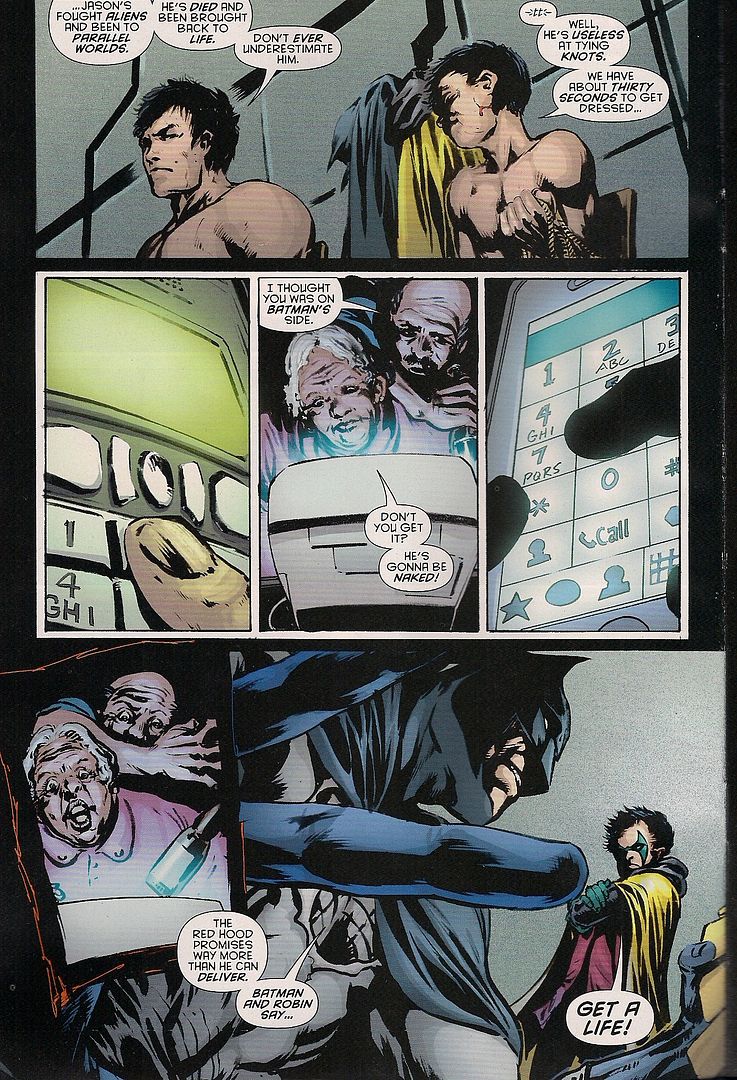 It's entirely possible the above image might just say it all, but I still feel obliged to point out that the image of Batman & Robin to the right is supposed to be what the people in the inset panel to the left are watching on their monitor.
It's entirely possible the above image might just say it all, but I still feel obliged to point out that the image of Batman & Robin to the right is supposed to be what the people in the inset panel to the left are watching on their monitor.
I haven't been quite as upset with penciller Philip Tan's work this storyline as some folks -- his shortcomings are roughly similar to those of Tony Daniel, who didn't attract half as much disapprobation with his Grant Morrison collaborations, despite something like R.I.P. needing a steadier visual approach far worse than this thing -- but there's no denying his awkwardness with visual humor, which also causes some trouble with this issue's much-hyped villain Flamingo. He's a joke character, basically, a flamboyantly-dressed super-glam superkiller ("I was expecting scary, not gay," muses Damian) who nonetheless communicates entirely in grunts and RRRs and cackles - the exclamation point at the end of writer Morrison's three-issue statement on cool and dark characters attempting to muscle out our reformed, uneasy Dynamic Duo.
Tan (with inker Jonathan Glapion) doesn't get much out of this sizzle/steak disconnect - that's more cover artist Frank Quitely's bread 'n butter (given one image, he immediately takes the opportunity to quote Purple Rain). Moreover, portions of the issue seem especially hurried, with some panels approaching Igor Kordey's "famous" issues of New X-Men in tortured posture. Pages seem to fade in and out of a richer, sooty look (and the character art seems to shift a little in style), suggesting that Alex Sinclair may have colored some parts directly from the pencils; the finished work ends up looking vaguely like a Hong Kong action comic with assorted panels painted for effect, but sloppier.

The troubles don't end there, however. One of the better ideas behind Batman and Robin as a series is that it takes the 'everything is canon' approach of Morrison's previous Batman run and applies it to a new Batman & Robin so as to strike out a fresh tone - a kind of fun-bloody romp through oddball villains and skewed team dynamics. The irony, naturally, is that Batman himself needed to be removed from the story in order for "Batman" to get on with forward-looking stories, as opposed to confronting his past all the time.
But Morrison tends to work best with grand summaries of superhero themes, which his doomy Bruce-as-Batman were inclined toward. Now that we're into the new Batman and the new Robin, we get... er, a story about whether Batman is dark enough and how really cruel superhero characters are kinda nasty, which is not only an old superhero concern -- even one of this issue's Batman-specific jokes on the 1-900 Kill Robin fiasco mostly reminded me of Rick Veitch's take in Brat Pack 19 years ago -- but something Morrison has done several times in the past; the struggle between creative forces of wise evolution and corroding grit was central to both Seven Soldiers and Final Crisis, just to name two big ones, and it's almost always been done with more depth and panache than present here. This series, however, keeps trying to be a sleek, fun superhero read, yet it remains so fixated on old themes it seems less light than shallow, as if Morrison was building up a Bat-apocalypse toward a new morning, then didn't quite know where to go once the sun was up.
The fact that the struggle between Dick Grayson and Jason Todd to follow Bruce Wayne fits neatly into this old scheme doesn't make the execution any more interesting; Batman's been around long enough that I'm well aware of how the shape of Bruce Wayne leaves a void that can't be filled. I mostly find myself thinking to Morrison's comments in interviews, about how Gotham City should have the most amazing arts scene in the world and stuff, and how nice it'd been to see those stories. This stuff - it's like build build build to Batman's death, then a new status quo that gets right on to build build build to Batman's return, since that's the implicit focus of a story like this. I know: big-ticket superhero comics in 2009. Maybe there's just nothing else to do. AWFUL.
***
PunisherMAX #1: In which Marvel finally kicks off its proper longform follow-up run to Garth Ennis' fine tenure on the Mature Readers Punisher book. And make no mistake - this may be a relaunch, and yes, it's sporting the silliest alternate spelling of a familiar brand since they started calling the devourer of worlds "Gah Lak Tus" in the Ultimate line, but this absolutely is a sequel to the Ennis run, which is paid all due specific homage via dialogue. So where does writer Jason Aaron take it? It's kind of hard to say; this is more of a prologue issue than anything, full of characters setting things up in between a few obligatory scenes of punishment. Pretty low key, as if it's just the next issue after Ennis left, and thus begging for a direct comparison between the writers' starting points.
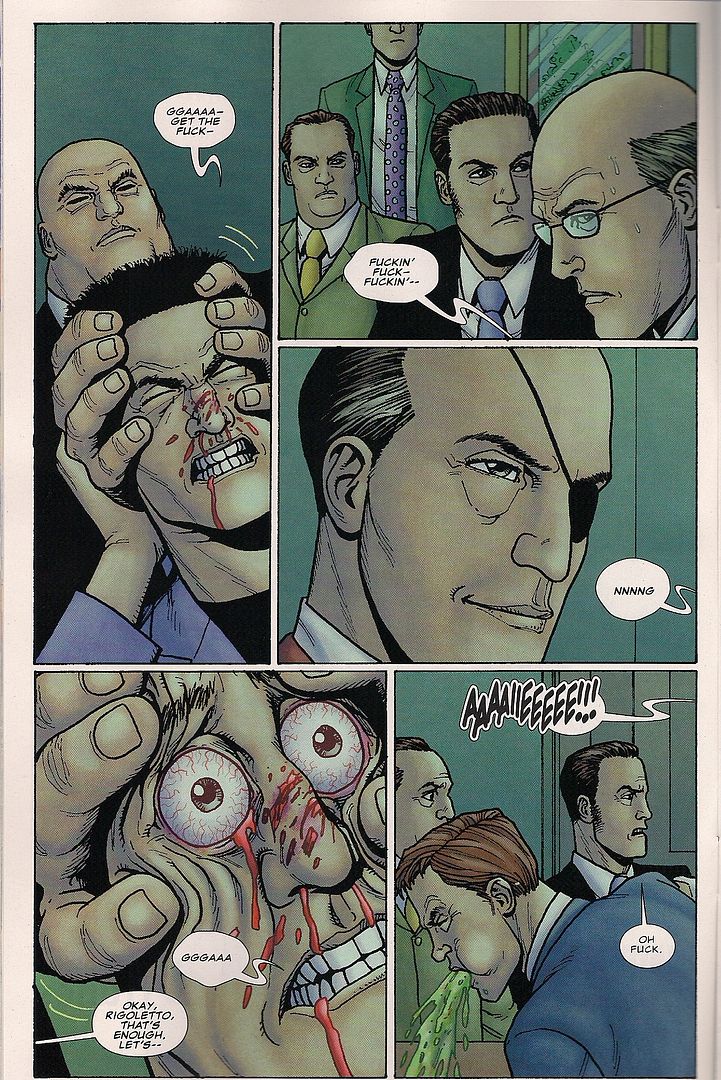
Still, it's interesting to see how Aaron tries to set himself apart, despite the able-as-ever presence of artist Steve Dillon, a man not unfamiliar to Ennis' readers. There's no Frank Castle narration, for one thing, which tosses the narrative focus right over to the criminals; Ennis spent a lot of time with the supporting cast too, but he usually planted us inside Frank's head to an extent that everything we'd see almost seemed filtered. Aaron plays a bit with our distance from Frank, depicting him coldly as a torturer, and declining to even show most of this issue's big firefight.
On the other hand, I caught a few worthwhile similarities to Ennis' own debut MAX story, In the Beginning. There a bit more gore than usual, as if the series is again stretching out to enjoy the relative freedom of the Mature Readers designation. There's also an interest in exploring Marvel U characters: Microchip in Ennis' story, the Kingpin in Aaron's. It's mostly a hook to attract readers from the wider pool of Marvel interest, I suspect, and striking in being cast out again for the relaunch, particularly in that the MAX line hasn't actually used that technique all that much in its development. Aaron's take on the Kingpin is a good one so far, acknowledging the absurdity of the Master of All Crime type sitting in a tower by having it exist mostly as an idea for Frank Castle (always the MAX series' most unrealistic man) to pursue over the mundanity of a real, cunning Wilson Fisk in the realistic-save-for-the-Punisher MAX world. Makes sense that it starts out as chit-chat, then! GOOD.
***
Starstruck #3 (of 13): I've written about this series before, at least concerning its prior incarnations as an off-Broadway play, a Heavy Metal serial, a Marvel Graphic Novel, an Epic Comics series and an expanded, b&w Dark Horse series. This is IDW's new release, with Michael Wm. Kaluta's art somewhat reconfigured from the Dark Horse expansion, freshly recolored/colored-for-the-first-time by Lee Moyer. Various Charles Vess-inked back-up strips are included too, some of them previously unseen and some of them straight out of The Rocketeer Adventure Magazine. You'll note that the publisher is also slated to present a recolored edition of The Rocketeer itself pretty soon (colors by Laura Martin), albeit as a collected edition rather than a new pamphlet series.
In some ways, this expanded-and-expanded again Starstruck seems slightly perverse in pamphlet form. Its 14-t0-18-page bites of the 'main' story ensures that the detail-heavy plot moves at a stately pace; this issue is marked by the birth of one of the series' main characters, while another is still a little kid in the back-up material. Even if you didn't already know that Starstruck is an unfinished series -- and that this particular incarnation should approximate the run of the Dark Horse issues, which itself only made just past the start of the Epic issues, roughly 1/3 of the way into the intended megastory -- you'd probably still get the feeling that a lot more space will be demanded for the already pretty damn large cast to play out its space drama.
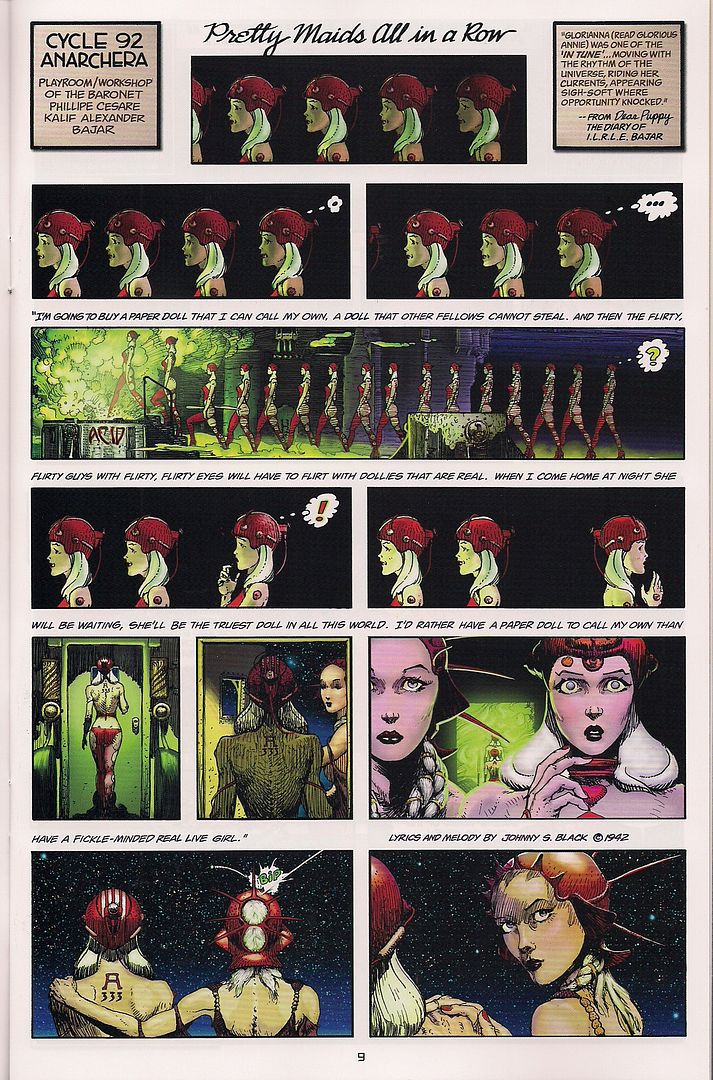
Yet Starstruck-the-pamphlet still seems oddly right, entirely because it's so nicely conceived (the editor is Scott Dunbier). It's no secret that the series has picked up a reputation for being 'difficult,' and almost everything in these $3.99 comic books seems primed to keep you oriented without holding your hand. Writer Elaine Lee provides new (in-character) introductions focused on the history of the series' universe, and encyclopedia entries keyed to each issue clarify exactly enough of the finer points before launching into additional digressions and odd jokes. Best of all, the story segments make great use of natural break points in Lee's fragmented narrative so you can linger on all those packed-in details. It works well enough that pages now getting their fourth English-language version give up new information, carefully shading Lee's vision of diverse femininity along the fringes of a future with more such peripheral room. VERY GOOD.
***
Hellboy: The Wild Hunt #8 (of 8): Quick quiz, what's Hellboy's main superpower? He's the best listener in the whole damn world!
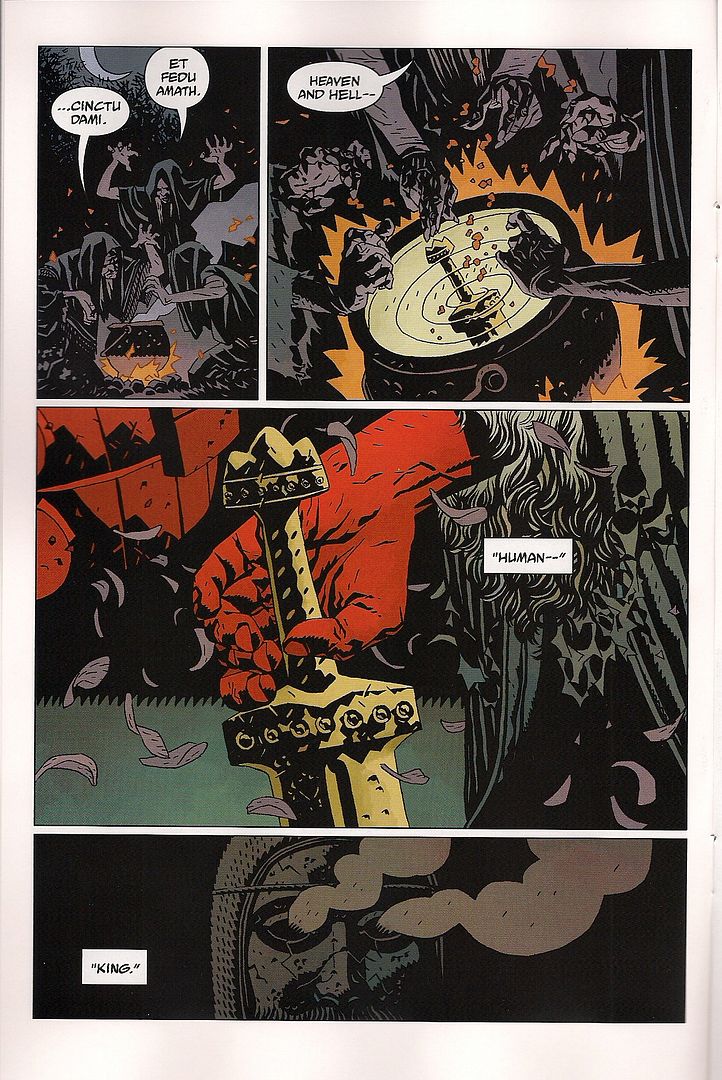
Aw, that's just a little joke from a compulsive Mignolaverse patron; I buy Hellboy comics like Tucker buys Batman. And I think the going estimate is that Our Man has spent a solid 65-70% of his 44 issues so far listening to folk tales and personal histories and ill omens and such, usually before kicking something's ass. I've always felt that formula grew out of the strong appeal creator Mike Mignola's art had for so many readers - his characters have always looked so fine peeking out from opaque shadows that long stretches of mood-setting seemed workable, and then monsters! and fighting! - he could do that too.
Mignola has since stopped drawing the series (mostly), though his stories have begun pouring out through many Hellboy universe projects, a unique shared-universe situation for the front of Previews in that every book demands a fairly high level of visual quality; granted, having Dave Stewart color almost the whole line and keeping A-level talents like Guy Davis and Richard Corben in the pool is bound to make an impression, but even the smallest of Mignola's series -- and he has a writer's credit on almost everything, with Scott Allie as constant editor -- seem bound by a mandate for technical aptitude that keeps the qualitative average remarkably high. Some of these comics can get bland and formulaic, sure, but shockingly few of them are ever really awful, which stands in sharp contrast to most other genre comics labels around.
The main Hellboy series remains a little bit apart, though, in that it is still primarily a visual spectacle. Oh, there's a plot, characters - shit, I can't even keep track of all the characters anymore, but the funny part is I also never feel like I need to. The Hellboy backstory has gotten almost insanely complicated, but it inevitably winds up offering only more scenic routes to vivid sights and massive fights, not to mention near-comedic levels of portent, which I suppose will climax with something, eventually. As it is it's nearly a meta-commentary on the superhero propensity for perpetual anticipation of Earth-shaking events and bigger, badder threats, always transformed into the largely visual experience that Marvel and DC comics usually can't provide.
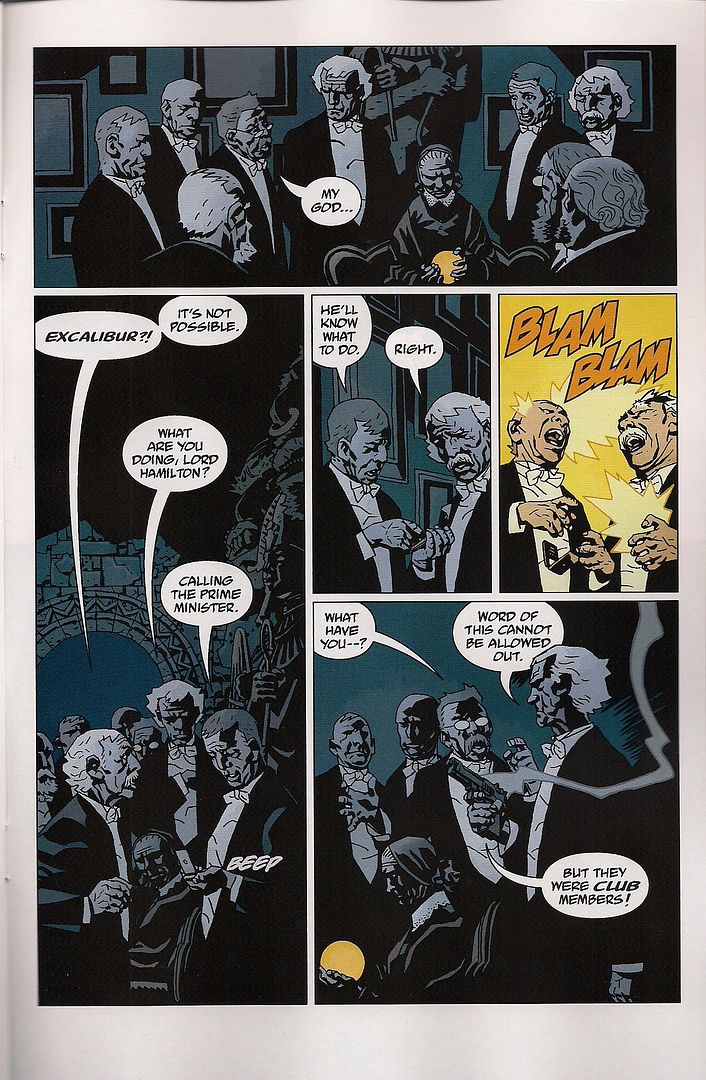
So here we've got the end of the new 'present day' Hellboy story, which has even more unique demands for an artist. Corben does a lot of work on Hellboy proper, say, but his past-tense stories allow for him to mostly do his own thing with Hellboy himself kept on-model. Duncan Fegredo, however, Mignola's most direct heir, is doing a genuinely eerie job of capturing Mignola's own cadence, the way he slices our perspective away to skulls on a shelf or a soaring bird; he does the heavy shadows too, but in his own way, and anyhow that was never all Mignola was about - his was a total vision on the page, always scanning the place for evocative images, sequence barely hanging on.
And despite all I've just said, Mignola's also about a bit more than just pretty pictures. This storyline is titled The Wild Hunt, which seems odd at first since the Hunt (for undead giants) ends in issue #2 and the story winds up building to yet more revelations about Hellboy's lineage... on his mom's side! But Mignola pulls a trick - the big unavoidable fight scene with the giants is cut to bits and then scattered through the rest of the story as flashbacks, all the better to hit on what has to rank as the most substantial bit of the title character's development since the 1990s: his realization that he really, truly, deeply enjoys having massive, violent fights, and that violence perhaps inexorably draws out the dark potential of his destiny as a son of Hell.
This is clever, and really kind of ballsy for a series so totally steeped in action as release; casting every ass kicked as one step closer to the throne of pandemonium has a way of signaling finality like nothing else for this series. Mignola then goes on to elaborate by cutting back constantly to the series' ex-elf shrunken giant warthog antagonist Gruagach, a hapless villain first introduced in 1996, doomed to start shit so much bigger than himself, his true origin told in a characteristic-to-the-series folk tale manner smoothed down to two and a half pages and hammer-blunt with fairy story cruelty, then his history with Hellboy summarized as a life-ruining encounter that clearly didn't mean so much to the guy talking with his fists; Hellboy's tough-guy line "Where's that baby?" is repeated so that it takes on a malevolent tone, which is surely the point.
It's true that this literary content probably didn't need eight issues of comics to go through, but the visual content feel like it did. Trees bursting into flame, spirit bodies constantly switching from fleshy to skeletal form, still-amazing page-to-page, panel-to-panel and in-panel contrasts in color - this is Hellboy's identity, and one that seems all the more assertive now that the basic, necessary parts of the plot are as liable for toying as the complicated decoration that is the title character's family saga and list of friends and foes. Who cares which magic sword he's drawn - how's he gonna use it now? Keep listening with your eyes. GOOD.











